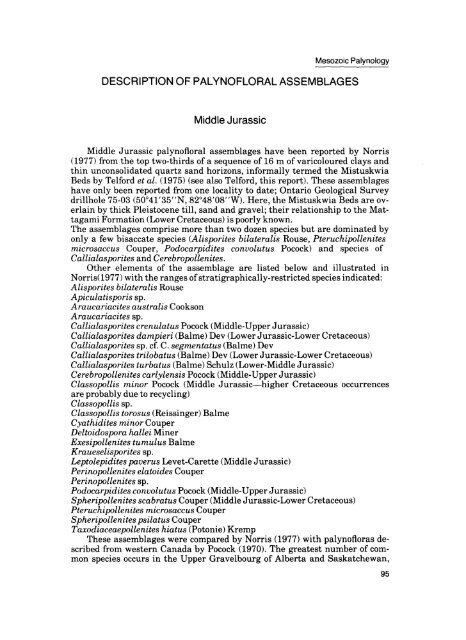Moose River Basin: geology and mineral potential - Geology Ontario
Moose River Basin: geology and mineral potential - Geology Ontario
Moose River Basin: geology and mineral potential - Geology Ontario
Create successful ePaper yourself
Turn your PDF publications into a flip-book with our unique Google optimized e-Paper software.
Mesozoic Palynology<br />
DESCRIPTION OF PALYNOFLORAL ASSEMBLAGES<br />
Middle Jurassic<br />
Middle Jurassic palynofloral assemblages have been reported by Norris<br />
(1977) from the top two-thirds of a sequence of 16 m of varicoloured clays <strong>and</strong><br />
thin unconsolidated quartz s<strong>and</strong> horizons, informally termed the Mistuskwia<br />
Beds by Telford et al. (1975) (see also Telford, this report). These assemblages<br />
have only been reported from one locality to date; <strong>Ontario</strong> Geological Survey<br />
drillhole 75-03 (50 041'35"N, 82 048'08"W). Here, the Mistuskwia Beds are ov<br />
erlain by thick Pleistocene till, s<strong>and</strong> <strong>and</strong> gravel; their relationship to the Mat<br />
tagami Formation (Lower Cretaceous) is poorly known.<br />
The assemblages comprise more than two dozen species but are dominated by<br />
only a few bisaccate species (Alisporites bilateralis Rouse, Pteruchipollenites<br />
microsaccus Couper, Podocarpidites conuolutus Pocock) <strong>and</strong> species of<br />
Callialasporites <strong>and</strong> Cerebropollenites.<br />
Other elements of the assemblage are listed below <strong>and</strong> illustrated in<br />
Norris(1977) with the ranges of stratigraphically-restricted species indicated:<br />
Alisporites bilateralis Rouse<br />
Apiculatisporis sp.<br />
Araucariacites australis Cookson<br />
Araucariacites sp.<br />
Callialasporites crenulatus Pocock (Middle-Upper Jurassic)<br />
Callialasporites dampieri (Balme) Dev (Lower Jurassic-Lower Cretaceous)<br />
Callialasporites sp. cf. C. segmentatus (Balme) Dev<br />
Callialasporites trilobatus (Balme) Dev (Lower Jurassic-Lower Cretaceous)<br />
Callialasporites turbatus (Balme) Schulz (Lower-Middle Jurassic)<br />
Cerebropollenites carlylensis Pocock (Middle-Upper Jurassic)<br />
Classopollis minor Pocock (Middle Jurassic—higher Cretaceous occurrences<br />
are probably due to recycling)<br />
Classopollis sp.<br />
Classopollis torosus (Reissinger) Balme<br />
Cyathidites minor Couper<br />
Deltoidospora hallei Miner<br />
Exesipollenites tumulus Balme<br />
Kraueselisporites sp.<br />
Leptolepidites paverus Levet-Carette (Middle Jurassic)<br />
Perinopollenites elatoides Couper<br />
Perinopollenites sp.<br />
Podocarpidites convolutus Pocock (Middle-Upper Jurassic)<br />
Spheripollenites scabratus Couper (Middle Jurassic-Lower Cretaceous)<br />
Pteruchipollenites microsaccus Couper<br />
Spheripollenites psilatus Couper<br />
Taxodiaceaepollenites hiatus (Potonie) Kremp<br />
These assemblages were compared by Norris (1977) with palynofloras de<br />
scribed from western Canada by Pocock (1970). The greatest number of com<br />
mon species occurs in the Upper Gravelbourg of Alberta <strong>and</strong> Saskatchewan,<br />
95

















